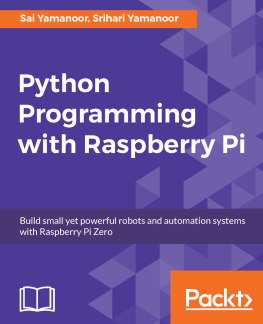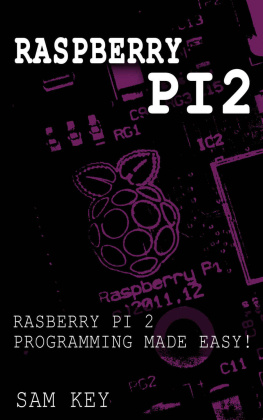Raspberry Pi 4 Programming Made Simple For Beginners
A Comprehensive Guide On How To Setup and Work With The Latest Raspberry Pi 4 and Develop 20 Cool Raspberry Pi 4 Projects
Jack Berg
Introduction
Nerd. One whose unbridled passion for something defines who they are as a person, without fear of other peoples judgment.
Zachary Levi
If you are planning to acquire a Raspberry Pi, or if you own one but have no idea how to get started with it, you have come to the right place.
Welcome to this Raspberry Pi 4 guide, a comprehensive guide for beginners and intermediates with projects. This book will ensure that you fully understand, utilize, and, more importantly, enjoy your Raspberry Pi 4 to the fullest.
We will start by understanding the inner workings of the Raspberry Pi. Then, we shall move on to setting up a compatible OS for our Pi so that we can start coding and building robots and automated projects we can use to control smart devices. From there, we shall move on to experimenting with all kinds of weird and cool projects.
The Raspberry Pi has played a revolutionary role in making computing technology accessible and affordable to everyone. People of all ages and gender are using this amazing device to create innovations that have the potential to improve the future.
If youre ready to use your Pi 4 to play your part, this a book will certainly help you.
Table of Content
Section 1
Getting Started with the Raspberry Pi 4
A computer is like a mischievous genie: it will give you exactly what you ask for, but not always what you want.
Joe Sondow
The Raspberry Pi is a fully functioning computer that comes in a tiny package and a very affordable price while prices vary based on computing power, the basic Pi 4 starts at $35.
Figure 1: Raspberry Pi 4 illustration including starting price
Whether you want a device that you can use to perform day-to-day computing tasks such as creating amazing programs, circuitry, or controlling other physical devices, the Raspberry Pi will adapt to whatever you need.
The Raspberry Pi brand is a full-fledged series of single-board microcomputers developed and maintained by the Raspberry Foundation.
Since its first development in 2012, the Raspberry Pi features have advanced drastically over the years. Today, it has illustrious capabilities and peripherals.
Since the initial release of the first Pi, the Raspberry Foundation has continued to release newer models, with newer models of the Pi supporting new features and capabilities.
The Raspberry foundation notes that today, they and third parties have sold more than 25 million Raspberry Pi kits all over the world, many of which have found use in classrooms, offices, factories, data centers, and homes where hardcore geeks use them for all sorts of things.
The Raspberry Pi is a single-board computer. That means its similar to a desktop, laptop, or smartphone but in a single circuit board.
Like most single board computers, the Raspberry Pi is simple and small, often the size of a credit card. However, the devices small size does not mean its less powerful than other desktop computers. In some use case scenarios, the Raspberry Pi can perform a task better than larger desktop computers.
Despite the improvements made on each new model of the Pi year after year, all Raspberry Pis still have one main thing in common: they are all backward compatible.
Backward compatibility means that programs and projects designed on older models of Pi will work on newer models and vice versa.
You can even run a newer version of the Raspbian OS on the very first model of the Pi. It will run slowly, but it will still run.
NOTE: The above notwithstanding, throughout this book, we will be using the Raspberry Pi 4 for illustrations. However, thanks to backward compatibility, the projects and concepts we shall discuss will work with other models of the Pi. Where you may experience compatibility issues, we shall present an alternative you can use.
The Raspberry Pi Hardware
Unlike large desktop computers that hide all the inner hardware components, the Raspberry Pi has every component exposed to the user, which allows easy modifications and troubleshooting. This nakedness also allows you to learn about core hardware components and how they work. It also allows you to manage any peripheral devices you connect to the Pi.
NOTE: If you wish, you can purchase a case to protect the Raspberry Pi, which is often better, especially since you can purchase a clear case.
The figure below shows the Raspberry Pi 4 from a birds eye view. If you have another model, your Pi might look slightly different. Do not worry; we will discuss what the various parts entail and how they work.
Figure 2: A birds eye view of the Raspberry Pi 4
Although the Raspberry Pi may seem to pack a lot of components into a single board, the parts are very simple and easy-to-understand.
Like most computers, the Raspberry Pi has particular components that play specific roles and help the Raspberry Pi function.
We will start by looking at what we can term as the most important part of the Raspberry Pi located at the center of the board covered in a metal cap: the System-on-Chip or SoC.
#: The Raspberry Pi 4 CPU
Although significant changes have happened with each new release of the Raspberry Pi, all models feature a Broadcom System on Chip (SoC) with an ARM-compatible CPU. The Pi has a clock speed range of 700 MHz to 1.5 GHz on the Raspberry Pi 4.
The Raspberry Pi 4 has a quad-core ARM Cortex-A72 processor, which is a successor to the Raspberry Pi 3 B+ processor quad-core Broadcom BCM2837BO that had a clock speed of 1.4GHz.
Raspberry Pi processors support overclocking at boot by running the command sudo raspi-config during the boot process on Raspbian Linux based distributions. Most of these processors are overclock-able up to 800MHz, 1000 MHz, and 1500 MHz on the extreme.
#: Raspberry Pi Memory
The Raspberry Pi Foundation has done a great job of improving the devices memory. Older models of the device featured 128MB allocated for the GPU, with another 128MB allocated to the CPU. The GPU in the Raspberry Pi is the Broadcom Video-core VI. The Raspberry Pi 4 comes in flavors of 1GB, 2GB, and 4GB.
#: Raspberry Pi Networking
Older models of the Raspberry Pi have no ethernet connectivity, and the only way to connect them to the internet is by using an external USB ethernet or a USB wireless adapter.
Newer models such as the Raspberry Pi B and B+ support gigabit ethernet and use it as the primary connectivity interface.
Later models of the Raspberry like the Raspberry Pi 4 also feature an 802.11ac wireless interface and a BLE 5.0 Bluetooth support. The Pi 4 also has Gigabit ethernet.
#: Raspberry Pi Storage
The default storage for the Raspberry Pi is a micro SD card. This SD card is what you will use to install the Operating system and as the default storage diskhowever, the Raspberry Pi 4 supports external storage devices via USB ports.
Those are the main features of the general Raspberry Pi. We left out some features that are specific to the Raspberry Pi 4 and not the entire Raspberry family. We shall now cover those:












